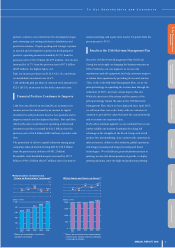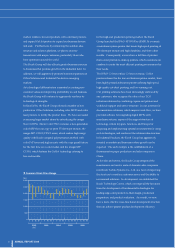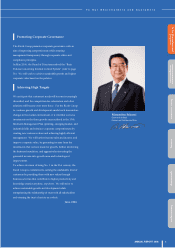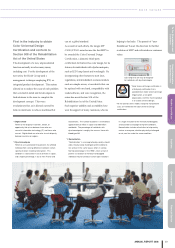Ricoh 2006 Annual Report Download - page 15
Download and view the complete annual report
Please find page 15 of the 2006 Ricoh annual report below. You can navigate through the pages in the report by either clicking on the pages listed below, or by using the keyword search tool below to find specific information within the annual report.
14
ANNUAL REPORT 2006
Environmental
Comparison of CO2 Emissions from Petroleum
Plastics and Bioplastics
Oil origin plastic
Oil Excavation
plastic
CO2
emissions
Vegetable origin plastic
Offset emission with absorption
CO2 absorption
plastic
imagio MP C1500
CO2
emissions
First in the photocopier industry
to use bioplastics
Ricoh seeks an alternative to
petroleum
Ricoh seeks an alternative to petroleum
As a manufacturer, It is the responsibility of
the Ricoh Group, to be selective about the
materials from which its products are made.
For us, the development of product materials
with low environmental impact has become
an important issue as “harmonize with the
environment” is one of our core values.
Bioplastics do not promote global warming
and cause little environmental impact. On
the other hand, before we could use
bioplastics in photocopiers, we had to
overcome numerous technical hurdles
including shock and flame resistance.
The Ricoh Group has worked with Mitsui
Chemicals since 2002 to conquer such issues
in practical use of bioplastics, and has carried
out many tests and refinements. As a result,
we have succeeded in developing a new
plastic material from corn, with a high plant
content of more than 50%. The new plastic
was used to form part of the shell for the
imagio Neo 602ec/752ec digital MFPs in
2005. In addition, the new material has
been used for part of the paper feed trays on
the imagio MP C1500, a standard model,
starting in February 2006.
The Ricoh Group will continue to improve
bioplastics to increase product application.
Bioplastics
Flow of Refurbished Machines in U.S. Market
Unique American recycled
machine business model catering
to the needs of the Latin
American market
The success of the recycled machine business
is key to realizing environmental
management. T he Ricoh Group launched a
full-fledged recycled machine business in
2004, through the teamwork of North
American and South and Central American
group companies in the Americas. In June
2005, Ricoh Industry Mexico (RIM), a
production plant, began refurbishing used
photocopiers collected from the North
American market. The refurbished
photocopiers are then sold by Ricoh Latin
America (RLA), a regional marketing
company. Thus a business model unique to
the Americas bringing products from the
North to the South was launched.
In the photocopier markets in South and
Central Americas, the number of used units
is said to exceed that of new units. In these
markets, due to outstanding quality, Ricoh's
refurbished units hold commanding shares.
We will further improve our organization to
more flexibly meet market needs by
expanding the sales of recycled machines.
American Recycling Business
raw material incinerationresin
Paper feed tray cover with bioplastic parts
To Our Shareholders and
Customers
General Information
by Business Area Ricoh's Core Values Solutions Environmental Financial Section
raw material incinerationresin
Recovered Products
Refurbished Products
Ricoh Industrial de
Mexico,S.A de C.V
North American
market
South & Central
American market
























